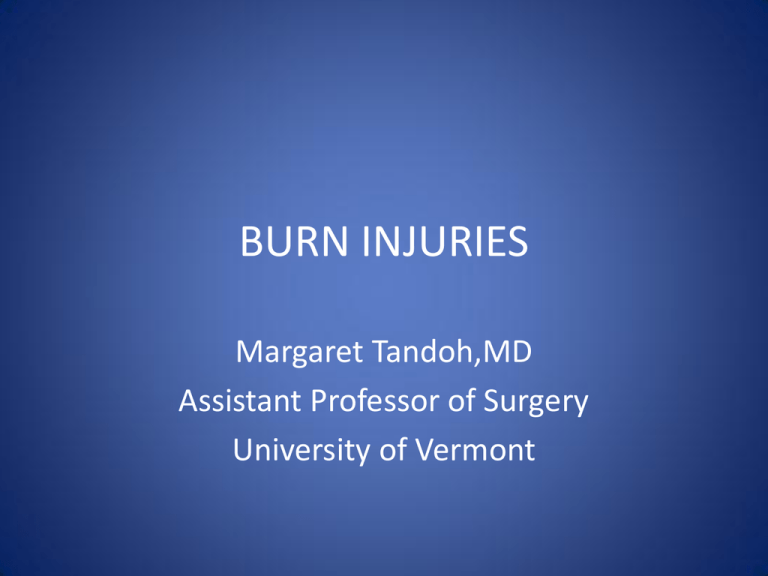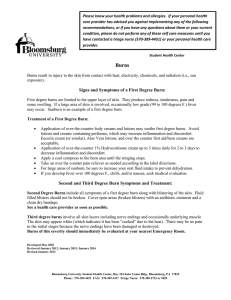burn injuries - University of Vermont
advertisement

BURN INJURIES Margaret Tandoh,MD Assistant Professor of Surgery University of Vermont OBJECTIVES • • • • TYPES OF BURNS HOW DEEP IS IT HOW MUCH IS BURNED HOW DO YOU CARE FOR THE BURN SCOPE OF THE PROBLEM • Burn injuries receiving medical treatment: ~450,000 • Hospitalizations: 45,000 (10%)-- ~25,000 at burn centers • Fire/Burn deaths/year: 3,500– 3,000 residential, 500 other(MVC, aircraft, etc) • 75% of deaths at scene or initial transport SCOPE OF THE PROBLEM • GENDER: 70% males, 30% females • ETHNICITY: 60% Caucasian, 19% African-American, 15% Hispanic, 6% Other CAUSES: – – – – – – Flame 44% Scald 33% Contact 9% Electrical 4% Chemical 3% Other 7% SCOPE OF THE PROBLEM • In severe burns: – 37% flame – 24% scalds – Structural fires: 50% of death due to CO, not burns ANATOMY • Largest organ • Protective barrier • Regulates temperature ANATOMY TYPES/CLASSES OF BURNS – THERMAL • • • • FLAME SCALD FLASH CONTACT TYPES/CLASSES OF BURNS – NON-THERMAL • • • • CHEMICAL ELECTRICAL RADIATION COLD PAHOPHYSIOLOGY OF THE BURN WOUND • Burn injury-coagulation necrosisincreased capillary permeability-fluid moves from intravascular space toward burn • Ebb phase – Initial decrease in CO, metabolic rate • Flow phase(after resuscitation) – Increase CO, resting energy expenditure PATHOPHYSIOLOGY cont’d • 3 zones of tissue injury: – Coagulation: dead or dying cells, most intimate contact with heat source – Stasis: vasoconstriction and ischemia, may convert to coagulation – Hyperemia: vasodilation, viable cells SCALDS • Most common cause of burns • Water at 140F causes full-thickness burns in 3secs, at 156F in 1sec. • Cup of coffee, 180F • Grease clings to skin • Thicker soups and sauces remain in contact longer FLAME • • • • • Most common in severe burns 67% in Caucasian population 66% involve a flammable liquid 63%, gasoline is liquid of choice 26% association with EtOH CONTACT • • • • Can be 4th degree Unconscious patients resting on hot surface Toddlers falling on to wood stoves Industrial accidents: contact and crush ELECTRICAL INJURIES ~ 20, 000 ED visits/yr ~ 500-1000 deaths/yr > 50% of deaths occur at workplace • 2-3% of burns in children ELECTRICAL BURNS • 3-5% of all admitted burns • Visible burned areas represent only a small portion of destroyed tissue • Electrical currentheat tissue with lowest resistance(nerves, vessels muscles) • Low-voltage: similar to thermal burns, only local damage, 110220 V • High-voltage:1000 V or more, CPR, full trauma evaluation, EKG monitoring • Multiple complications: cataracts(up to 30%), neurologic CHEMICAL BURNS • • • • • • Most are from household cleaners Industrial exposures Injury caused by protein destruction Speed is essential in management Copious lavage with water Alkalis: lime, KOH, bleach, cement(calcium oxide), NaOHusually deep • Acids:protein breakdown by hydrolysishard escharnot as deep as alkalis ASSESSMENT OF THE BURN WOUND • Outcome dependent on depth and extent of injury • Extent of injury – Rule of nines – Lund Browder chart – Palm size(of patient) including digits DEPTH OF BURN • 1st degree – Epidermis only, painful, dry, heals in ~ 7days, no scars • 2nd degree – Superficial: various portions of superficial dermis, painful, moist(dermal vessels present), blisters, minimal scarring, heals in ~ 14 days DEPTH OF BURN • 2nd degree – Deep: usually insensate, no blisters, treat like 3rd degree • 3rd degree – Full-thickness necrosis, painless, dry, can be any color, will scar, needs excision • 4th degree – Underlying structures(muscle, bone) involved FOURTH DEGREE • Extends into muscle, bone, etc SIZE OF THE BURN WOUND INITIAL MANAGEMENT • • • • • Airway Breathing Circulation Disability Exposure/environment INITIAL MANAGEMENT • • • • • • Cover with clean dry sheet Irrigate copiously chemical burns) No antibiotics No ice Leave blisters Tetanus prophylaxis INITIAL TREATMENT • Stop burning process • Primary and secondary survey • Resuscitation: Parkland(4ml/kg/% TBSA) and Brooke(1.5ml/kg/%TBSA + 0.5/kg/%TBSA) • Escharotomies: edema impedes venous outflow and then arterial inflow. Look for numbness and tingling in limbs, increased pain in digits • Tetanus WOUND CARE • Early excision and grafting deep 2nd and 3rd degree wounds • Full-thickness skin grafts:decreased contracture, but limited and can only be used once. Not commonly used in burn wounds. • Split-thickness skin grafts: commonly used FROSTBITE • 1805: first modern report published • 1814: Dominique Larrey(Surgeon General of Napoleon’s forces) described frostbite in the forces during the campaign in1812-1813 • His treatment held for over 150 years! • Friction massage with snow or ice, rather than thawing rapidly PATHOPHYSIOLOGY • Direct cellular damage and death – Caused by extracellular ice crystals – Rapid coolingintracellular ice crystals, more severe cell damage Progressive tissue ischemia Wet/moist skin more susceptible Alcohol use very common CLASSIFICATION • Based on acute physical findings and imaging after rewarming: • Frostnip: no ice crystals, no tissue loss, not frostbite, but may precede it • 1st degree: numbness, erythema, mild edema • 2nd degree: clear or milky blister, erythema, edema • 3rd degree: hemorrhagic blisters • 4th degree: extends into muscle or bone SIGNS AND SYMPTOMS • 90% is acral • Ears, nose, cheek, penis also involved • Numbness prior to rewarming, then severe pain, usually throbbing • Tingling can occur • Initial appearance can be deceptive TREATMENT • Rapid rewarming • Temperature should be 40-42C for 15 – 30 mins or until complete • Tetanus • Drain clear blisters, leave bloody blisters • NSAIDS REMINDERS/PRACTICALS • • • • • • Smoke alarms save lives Set water temperature to 125F Avoid ice to burns Dry socks in the winter Take oxygen off when smoking Smother oil fire, no water REFERENCES • Some pictures from Google Images • Total Burn Care, 3rd edition • McIntosh, S et al. Wilderness Medical Society Practice Guidelines for the Prevention and Treatment of Frostbite, Wilderness & Environmental Medicine. 22, 156-166(2011) • ABA Fact Sheet 2011



